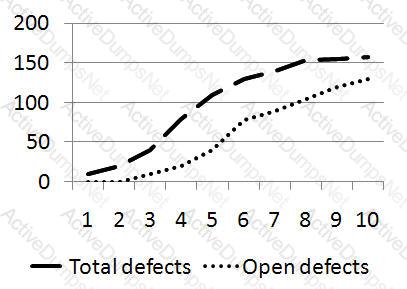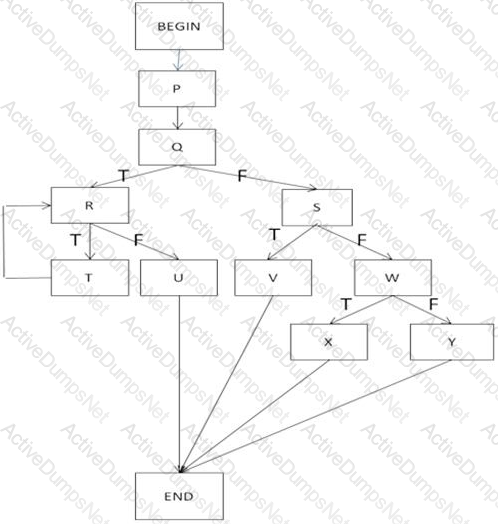A number of options have been suggested for the level of independence to be employed for the testing on the next project, and are shown below.
i. External test specialists perform non-functional testing.
ii. Testing is outsourced.
iii. Testing is carried out by the developer.
iv. A separate test team carries out the testing.
v. Testing is performed by the business.
vi. Testing is performed by a different developer.
Which of the following orders the above in a correct order of independence? 1 credit
Which of the following is a valid drawback of independent testing? 1 credit
Which of the following is a benefit of independent testing? 1 credit
Which of the following phases in the fundamental test process is considered to deliver a document which can be used as a major input for test process improvement? 1 credit
During test process improvement it is recommended to use standards where possible. Standards originate from various sources and they cover different subjects in relation to testing Pick TWO sources of software standards, useful to software testing from the ones mentioned below. 1 credit
Identify the THREE types of formal peer reviews that can be recognized. 1 credit
Which test management control option is most appropriate to adopt under these circumstances? 2 credits
Which of the following is a project risk mitigation step you might take as test manager? 1 credit
Which of the following is least likely to be used as a technique to identify project and product risks? 1 credit
Which of the following is not a quality characteristic listed in ISO 9126 Standard?
Which of the following statements are TRUE? A. Regression testing and acceptance testing are the same. B. Regression tests show if all defects have been resolved. C. Regression tests are typically well-suited for test automation. D. Regression tests are performed to find out if code changes have introduced or uncovered defects. E. Regression tests should be performed in integration testing.
Complete statement and branch coverage means..?
The business has asked for a weekly progress report. Which of the following would be appropriate as a measure of test coverage? 2 credits
As a result of the RAD based development approach, the test manager has decided to change the risk mitigation approach. Which test technique might be most appropriate to use? 2 credits
Why might a RAD approach be a better option for the test manager rather than a sequential development? 2 credits
Since the system is in the medical domain and therefore in the safety critical area, testing needs to be rigorous and evidence is required that the system has been adequately tested. Identify THREE measures that would typically be part of the test approach in this domain and which are not always applicable in other domains! 1 credit
You have been given responsibility for the non-functional testing of a safety-critical monitoring & diagnostics package in the medical area. Which of the following would you least expect to see addressed in the test plan? 1 credit
You are about to release a test progress report to a senior manager, who is not a test specialist. Which of the following topics should NOT be included in the test progress report? 1 credit
Comparing TMMi and TPI, which is not a valid reason for choosing either TPI or TMMi? 2 credits
Model characteristics:
Which THREE of the below mentioned characteristics relate to TMMi? 1 credit
The test improvement project will take place in an organization developing a safety-critical avionics application. Which one of the following standards do you believe would be most appropriate to take into account for compliance during your assignment? 1 credit
Which of the following is a defect that is more likely to be found by a static analysis tool than by other testing techniques?
Why is measurement of code coverage Important?
Which of the following does NOT represent one of the three triggers for maintenance testing an operational system?
In general which part of the testing activity is most difficult to estimate? 1 credit
Identify THREE items that would be part of the work-breakdown structure showing the key testing activities for the acceptance test project. 2 credits (for 2 out of 3 correct 1 credit)
Which aspect in the test estimate is the main risk in this project? 1 credit
In addition to risk, identify TWO other components of a testing strategy. 1 credit
You have been asked to write a testing strategy for the company. Which statement best explains how risk can be addressed within the testing strategy? 1 credit
Part of the testing strategy indicates that you are going to be using systematic test design techniques. Your manager has asked that you present the main advantages of using these techniques at the next board meeting. Identify THREE main benefits of using systematic test design techniques within this company. 2 credits (for 2 out of 3 correct 1 credit)
Relying only on the information provided in the scenario, select the TWO items and/or features for which sufficient information is available to proceed with test design. 2 credits
Continuing with the Scenario described in the previous question, which of the following topics would you need to address in detail in the master test plan? 3 credits
Given is the following defect removal chart reported at the end of system testing - showing total defects detected and closed defects (fixed and successfully retested). A number of open defects are classified as critical. All tests have been executed.

Based on the chart above, what is the most appropriate next test phase? 1 credit
Evaluate the status of the project against the defined exit criteria. Which of the following options shows the correct status? 2 credits
The development manager is managing the review of the responses received from bidders, and has asked the in-house test manager to provide a review checklist for the test management aspects of the responses. Which of the following checkpoints would be appropriate? 2 credits
Which of the following product risks would be most effectively addressed just by static testing? 3 credits
Select THREE issues from the options provided that should at least be raised. 1 credit
Which of the following would you least expect to form part of the analysis of initial tool costs? 1 credit
Instead of having an independent test team within the company, the company is considering to outsource testing. What are THREE key challenges that are typical for outsourcing? 1 credit
What is the Risk Priority Number for risk item number 2? 2 credits
What would be a test approach regarding the test design techniques to be applied that would fit an item with the highest risk? 2 credits
Which of the following team roles would be most appropriate to enhance the team and why? 2 credits
Which of the following would be the TWO most appropriate examples of entry criteria documented in the system integration test plan? 2 credits
Which of the following are valid reasons for adopting a different life cycle (from the V model), for increments after the first year? 2 credits
i. We do not have a clear understanding of the requirements from a customer perspective.
ii. We see the risk of delivering requested functionality late as being higher than the risk of delivering a lower quality product.
iii. We do not have a budget for additional regression testing which is needed to ensure that existing functionality is not compromised by future iterations.
iv. The company test strategy does not fit well within the V life cycle model.
Which of the following would be the most significant input to estimating the time to carry out the specified testing tasks? 3 credits
As part of the test strategy, entry and exit criteria will be defined for each test level. Which is NOT a valid reason for using entry and exit criteria? 1 credit
Within the projects, a master test plan and phase test plan will be used. Following is a list of characteristics applicable for test plans:
a. Any deviation from the procedures described in the test
b. strategy document
c. The overall estimated costs, timescales and resource
d. requirements
e. A detailed schedule of testing activities
f. The development deliverables to be tested
g. Which test staff members (names) will be involved and when
h. Level of requirements coverage achieved
Which TWO of the above mentioned characteristics relate to the phase test plan? 1 credit
Which THREE activities would be valid steps during the development of the test strategy?2 credits (2 out of 3 correct 1 credit)
Which statement correctly describes debugging? [K2]
The flow graph below shows the logic of a program for which 100% statement coverage and 100% decision coverage is required on exit from component testing. [K4]
The following test cases have been run:
Test Case 1 covering path P,Q,R,U
Test Case 2 covering path P,Q,S,V
Test Case 3 covering path P,Q,S,W,X
Test case 4 covering path P,Q,S,W,Y
Refer to the exhibit
